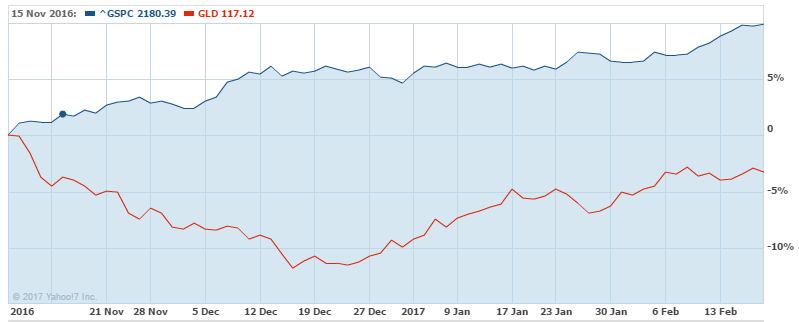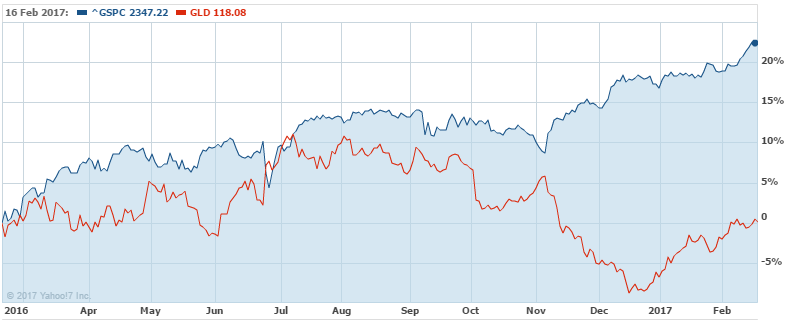I am still intrigued by the US markets reaction to the results of the US election when viewed in tandem with an instrument such as gold which is generally seen as a hedge against uncertainty (in this instance read outright dickheadedry) As such I though I would look at the relative returns of both instruments over a series of times frames if that told me anything about the market currently being uncertain about its own uncertainty. In looking at these two instruments I have cheated a little bit in that I am using a proxy for gold. I am using GLD which is an ETF that tracks the physical price of gold. I accept that this is a broad brush approach given the nature of the construction of GLD. However, I am looking for at a battleaxe approach not a rapier so the small inconsistencies dont bother me. I am more interested in looking at the broad pattern. If you have to look too hard then there is no pattern at all. If the relationship is not then when being as subtle as a sledgehammer then it is not there at all.
The firts thing I wanted to do was to look at the relative performance of the two since the US election and this can be seen in the chart below.
My reading of this from left to right is that Trump wins the election and the long term rally that has been in place since 2009 reasserts itself with equities taking off and GLD drifting. A few weeks later the ramifications of electing a buffoon become apparent and the market stalls and GLD rallies slightly. We now have the situation where the market is rallying in the short term as is GLD. A cynic might suggest that trades are hedging their bets a little.
However, it is important to note that these sorts of performance comparisons are dependent upon the starting date. If I roll the starting date back a year a different picture emerges.The big picture alters every time you change the starting date.
We can see that GLD actually begins to drop off in the second half of 2016 as physical gold runs into a wall and begins to fall back. The out performance of the S&P500 over this time becomes even more apparent but the bounce in GLD is still there but the performance of the S&P500 is so much more apparent. This raises the question as to whether this sort of analysis whilst mildly interesting on an academic basis actually provides any insight that is worthwhile. Such a question also highlights a simple fact of analysis and of system design in general. Everything you do needs to add some form of value to the system. Unfortunately academic interest does not add value to a system so on this basis my feeling is that this sort of thing doesn’t add any value outside of curiosity and the vague conclusion that traders are uncertain about being uncertain. To be blunt you have to ask the question does it help make money since that is the aim of trading. For some it might but for me it just kept me occupied for half an hour.









I agree with you CT – I don’t know what it means either and I probably don’t need to. I have got what is probably a bad habit of listening to ABC Radio news channel in the car, or sometimes if I am up working later at night – at the moment it is consumed by media people making up every kind of narrative imaginable to explain scenarios related to Trump. He is basically an analysts bonanza.
It’s interesting. When we observe things that we can’t explain utilising intellectual strategies that have worked in the past we respond in different ways. But at different points in history no amount of mental endeavour would have solved the perceived problems because the knowledge base was inadequate. The explanation for the movements of the stars and planets in the night sky would originally have been so, etc. The development of Game Theory by Nash et al made sense out of apparent random behaviour = a new way of perceiving elements of the world. We have had conventional ways of understanding the relationship between movements of various national and international instruments, including gold, currencies, bonds, commodities and equities. The relationship between S&P500 and GLD raises our interest, then our confusion because maybe we can’t see any consistent pattern. Is the relationship random or is it not yet understood? Another reason for failing to understand is that the parameters are too complex. If there is a relationship, are the parameters simple and static, or mutable over time? Maybe only multivariate analysis can resolve the problem, provided that we are aware of all the potential parameters. It’s still interesting.
A rapier won’t replace the big bits.